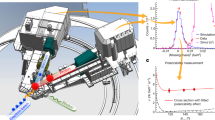Summary
A static plus spin-orbit proton-proton potential model has been derived semiphenomenologically. The potential resolves asymptotically to the one-pion-exchange potential and has been fixed in the region withinF=1.5Ħ/Μc by matching the 310 MeV MacGregor-Moravcsik-Stapp phase shift solution no. 1. The resulting potential gives an improved fit to the p-p scattering data over the 40 to 310 MeV energy range.
Riassunto
Si è derivato in modo semifenomenologico un modello del Potenziale statico positivo spin-orbita nell’interazione protone-protone. Il Potenziale si avvicina asintoticamente al potenziale di soambio di un pione ed è stato fissato nella regione entror=1.5Ħ/Μc verificando la soluzione no. 1 di MacGregor-Moravcsik-Stapp per lo spostamento di fase a 310 MeV. Il potenziale risultante dà una migliore approssimazione ai dati di scattering nella regione di energia da 40 a 310 MeV.
Similar content being viewed by others
References
P. S. Signell andR. K. Marshak:Phys. Her.,106, 832 (1957);109, 1229 (1958);P. S. Signell, R. Zivn- andR. E. Makshak:Phys. Rev. Lettt.,1, 416 (1958).
J. L. Gammel. andR. M. Thalek:Phyn. Rev.,107, 291 (1957).
H. P. Stapp, T. J. Ypsilantis andN. Metropolis:Phys. Bev.,105, 302 (1957).
S. Gartenhaus:Phys. Rev.,100, 900 (1955).
M. Konuma, H. Miyazawa andS. Otsuki:Progr. Theor. Phys. (Kyoto),19, 17 (1958).
M. Taketani, S. Machida andS. Ohnuma:Progr. Theor. Phys. (Kyoto),6, 638 (1951);7, 45 (1952).
S. Okubo andS. Sato:Progr. Theor. Phys. (Kyoto),21, 383 (1959).
M. Sugawara andS. Okubo:Phys. Bev. (to be published).
M. H. MacGregor, M. J. Moravcsik andH. P. Stapp:Phys. Rev.,116, 1248 (1959).
T. Hamada, J. Iwadare, S. Otsuki, E. Tamagaki andW. Watari:Progr. Theor. Phys.,22, 566 (1959).
B. P. Nigam:Progr. Theor. Phys. (Kyoto),23, 61 (1960).
L. H. Johnston andD. A. Swenson:Phys. Rev.,111, 212 (1958);J. N. Palmieri, A. M. Cormack, N. F. Ramfey andR. Wilpon:Ann. Phys.,5, 299 (1958);C. P. Hoang et al.:Phys. Rev. (to be published) ;A. E. Taylor (private communication);E. Baskir, E. M. Marshak, A. Roberts andJ. H. Tinlot:Phys. Rev.,106, 564 (1957);O. Chamberlain, E. Segr]è, R. D. Tripp, C. Wiegand andT. Ypsilantip:Phys. Rev.,105, 288 (1957);O. Chamberlain, E. Secrè andC. Wiegand:Phys. Rev.,83, 923 (1951).H. P. Stapp, T. J. Ypsilantis andN. Metropolis (ref. (3));A. Ashmore (private communication).
Author information
Authors and Affiliations
Additional information
This work supported in part by IBM Corporation and the U.S. Atomic Energy Commission.
Rights and permissions
About this article
Cite this article
Bryan, R.A. New semiphenomenological proton-proton potential. Nuovo Cim 16, 895–902 (1960). https://doi.org/10.1007/BF02771708
Received:
Published:
Issue Date:
DOI: https://doi.org/10.1007/BF02771708




